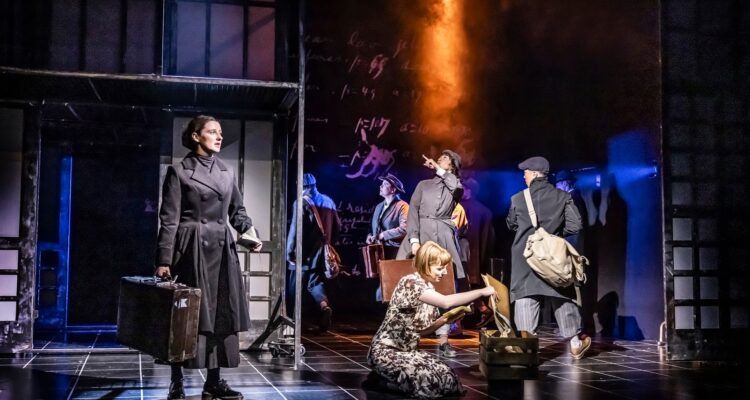Plays about famous women are thankfully on the increase and scientist Marie Curie is one that deserves recognition. Determined to fill in the empty spaces of the Periodic Table, Curie discovered Polonium and Radium for which she won the Nobel Prize twice, while forging a space for herself in an all-male dominated environment. With twenty-two songs about her journey, the musical is more singing than dialogue, with high production values and a talented cast. Sadly though, the later scenes contains more misery than joy.
The play opens happily enough with Marie travelling from Poland to Sorbonne University in Paris meeting her new friend, Anna. They sing about their hopes and their dreams, but many of these are shattered early on as they struggle against obstacles put in their way. As the only woman at the Sorbonne, Marie is derided by the science faculty and refused a laboratory in which to work. She meets her husband, Pierre Curie, admirably played by the pale and interesting Thomas Josling and together they work on their experiments. It is not so easy to make music out of the pitchblende separation on which Curie devoted much of her work, but the company do a splendid job.
One of the highlights is ‘Radium Paradise’ as Marie and Pierre discover the element which glows in the dark. Excitedly, the cast sing and dance joyfully, each holding a glowing green light, yet unaware of its dangers. Entrepreneurs spring up wanting to create such novelties as radium chocolate, radium toothpaste and radium cigarettes, eager to show the world this discovery. Curie’s rich backer moves to produce clocks with glowing numbers that can be seen in the dark. It is the fate of the in-house workers who paint these numbers with which the musical becomes mainly concerned. They became sick and died of pernicious anaemia or necrosis of the jaw from ingesting radium. From here on, misery pervades the discovery with songs like ‘Line of Death’ and ‘In the Darkness’, less of a celebration and more of a horror story.
The conflict really ought to be Curie’s ignorance of the situation and the concerns between her scientific urge to continue with her discovery and her philanthropic concern for the workers, but she is given the evidence of their illness early on and what dramatic tension there might have been is lost. There is also too much of a focus on what the workers suffer and not enough on what Curie achieves. Song and dance numbers revolve around how ill the workers are and how they are deliberately misdiagnosed as having syphilis; the development of X-rays and Curie’s deployment of X-ray machines is mentioned in prose in a coda at the end of the musical.
The exciting set is based around a triangular set of steps which swivel round with a laboratory on one side and a set of calculations on the other which also act as an altar when a worker dies. Ailsa Davidson is on top form as Marie giving the exact amount of subtly to her performance, of a caring but inward- looking, obsessive workaholic. Curie’s Polish friend, and later an affected factory worker, is boldly played by Chrissie Bhima, her performance perhaps a little too feisty as it sometimes gives the impression there are two female leads. While the jazz number livens up the evening, there is not really enough musical variation to the songs – though the lyrics push the action, neither lyrics nor music are memorable.
Marie Curie is a truly heroic story of a fight against sexist prejudice with a genuine love story between Pierre and Marie Curie and one deservedly told. The show highlights the terrible aspects people went through to find such a discovery, and is a worthy attempt by Korean writer Seeun Choun to highlight the ethical difficulties in science.
Genre: Musical
Book & Lyrics: Seeun Choun
Music: Jongyoon Choi
Director: Sarah Meadows
Choreographer: Joanna Goodwin
Cast: Ailsa Davidson, Chrisse Bhima, Thomas Josling, Richard Meek, Lucy Young
Performance Dates: 1st June – 28th July 2024
Performance Time: 1 hour 40 mins

